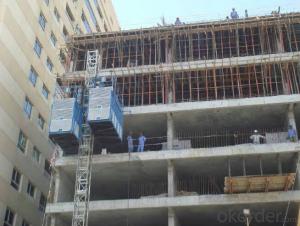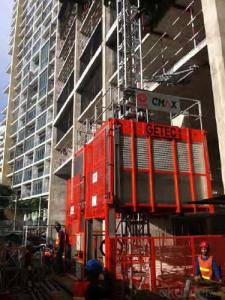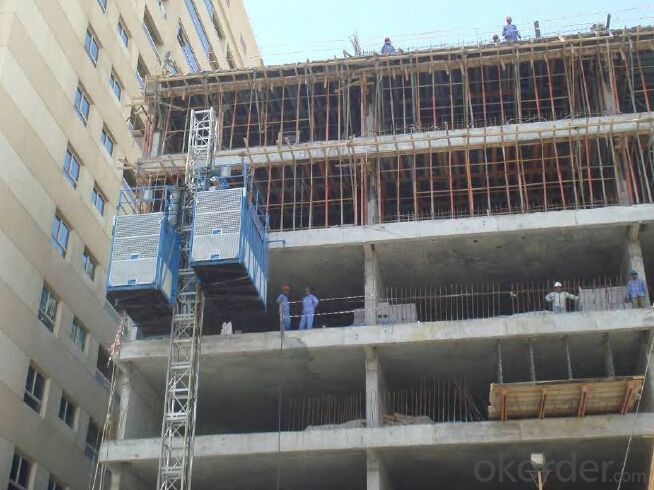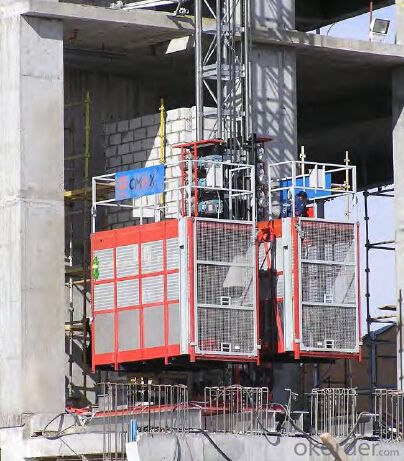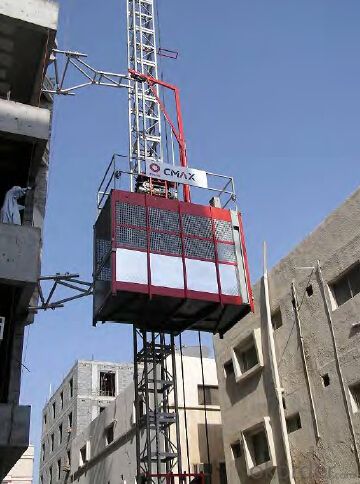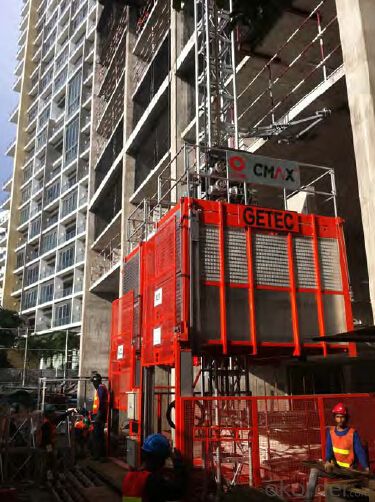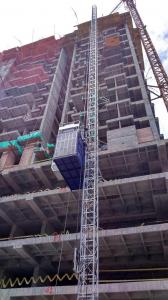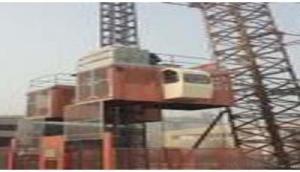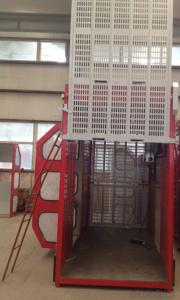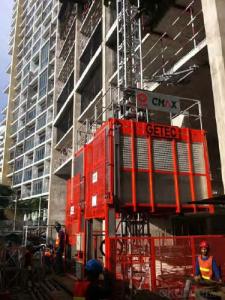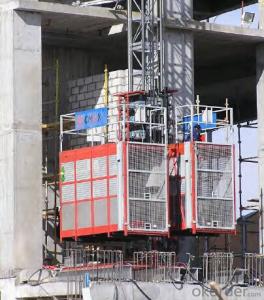SC200/200 Building Hoist, Construction Elevator Factory Price
- Loading Port:
- Tianjin
- Payment Terms:
- TT or LC
- Min Order Qty:
- 1 unit
- Supply Capability:
- 3000 unit/month
OKorder Service Pledge
OKorder Financial Service
You Might Also Like
SC200/200 3*2*11kw building electric hoist
Descriptions of our building hoist:
The general building hoist manufactured by our company have the features as good quality, long life, wide application range and convenient for maintenance, the gering adopts imported bearing, enameled cable, and oil seal, the electric parts adopt products from world renowned manufactures such as Schneider, Siemens, and LG, the racks and pinion adopts special material and heat-treatment technique, which prolong the life of these parts. The steel structure uses quality steel from famous domestic manufacturers, the surface of the structure can apply paint-spray, Parkerizing baking finish or hot galvanizing processing according to users requirements, the cage can be produced and decorated by aluminum molded board, punched-plate or figured aluminum board.
Main Features of Building Material Hoist
1. the recommended cage dimension(LXWXH):2.0X1.0X2.5, 2.5X1.0X2.5, 2.5X1.3X2.5, 3.0X1.5X2.5, 3.2X1.5X2.5, 3.8X1.5X2.5, 4.0X1.5X2.5, 4.2X1.5X2.5 etc, we can also manufacture cages of other size according to the user.
2. The cage and the door material can be aluminum molded board, punched-plate, figured aluminum board or other type according to your requirements.
3. The mast and the tie-in surface can adopt paint-spray, or hot galvanizeing processing.
Advantage of our building hoist:
1. Our own systems of production engineering.
2. Production design from the concept to the engineering details.
3. Technical experts with great experience in the sector.
4. Continuous development of new solutions and products adapted to the requirements of our clients.
5. Methodology and project procedure administration in compliance with current guidelines.
6. Extensive worldwide commercial network
Specification of our building hoist:
1. Rated load: 2×2000kg
2. Limit of load: 2×20(person)
3. Rotation lifting speed: 34.3m/min
4. Max. hoisting height: 150m
5. Size of hoisting cage: 3×1.5×2.7mmm
6. Rated of electric motor:11×3×2(kw)
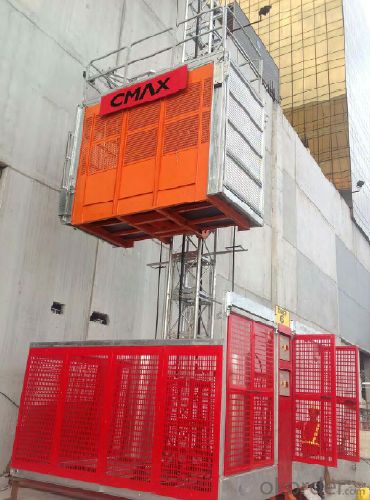
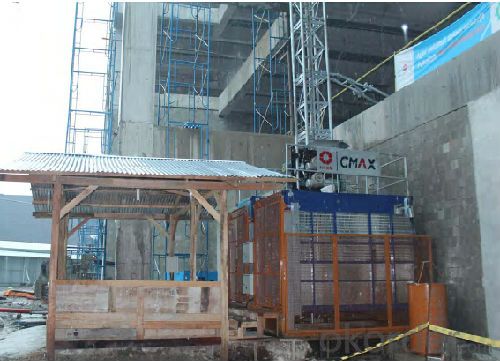

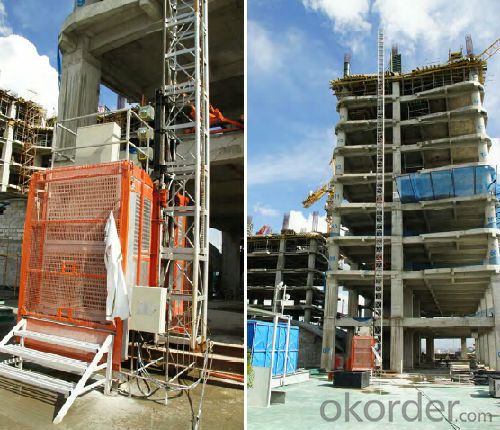
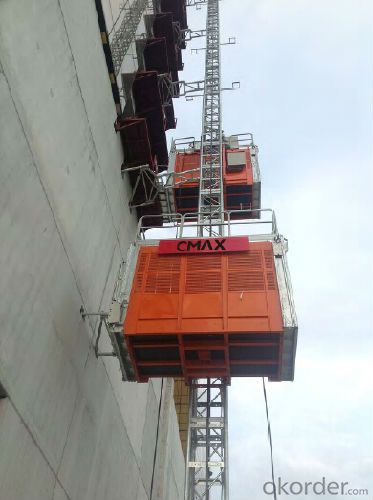
Production line
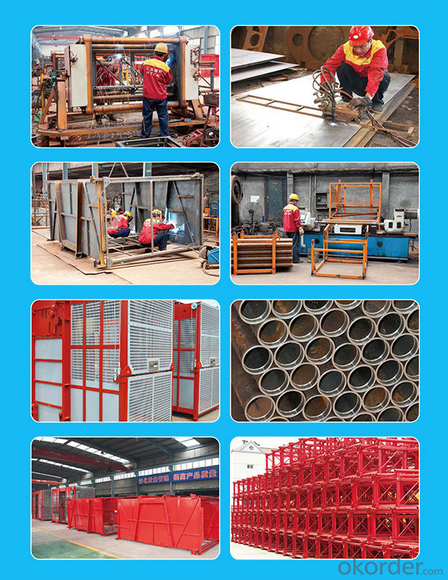
FAQ
1. why chose us?
China National Building Materials (Group) Corporation (CNBM), established in 1984,now is one of the largest state-owned group corporation in China, dealing with building materials & industrial equipment. Up to year 2010, CNBM Group's total asset is 20 billion USD and total staff is more than 100,000.CNBM International Corporation, specializes in designing & manufacturing of various
kinds of construction machinery, including tower crane, building hoist, etc. All the equipment produced by CNBM are compliant with the National level quality standard, and wins great reputation for their endurable performance in worldwide markets.
2.How about the shipment?
You can put 2 sets of of wheel loaders in one 40HQ container. The spare parts are packed with boxes.
The delivery time is 20 days.
3. What about your service?
We have our factory, we can meet customers needs as soon as possible.
We have first rate professional technology and provide good after-sales service.
4.After Sales Service
We offer the Preventative Maintenance and After Sales Service. For we strongly feels about the importance of supporting our customers and the product solutions we provide. Consequently we offer comprehensive maintenance options to prevent equipment issues before they become problems. Also we offer one year guarantee period.
- Q: Is it possible to use a building hoist for lifting delicate or fragile items?
- <p>A building hoist is typically designed for heavy construction materials and not recommended for lifting fragile objects. The vibrations and force exerted during lifting can damage delicate items. For fragile objects, specialized hoists or cranes with controlled movements and gentle handling capabilities are advised to ensure safety and prevent damage.</p>
- Q: This question asks for a comparison between manual and automatic lifting systems used in construction equipment, highlighting their distinct features and operational differences.
- <p>Manual lifting systems in construction equipment rely on human effort to lift and move materials. They are often less expensive, require less maintenance, and are suitable for lighter loads or smaller-scale projects. However, they are labor-intensive, can be slower, and pose higher risks of injury due to the physical demands. Automatic lifting systems, on the other hand, use mechanical or electronic means to lift and move materials. They are more efficient, can handle heavier loads, and reduce the risk of injury by minimizing manual handling. These systems are often more expensive and require regular maintenance but offer precision, speed, and ease of operation, making them ideal for large-scale construction projects.</p>
- Q: Can a building hoist be utilized for the purpose of lifting heavy machinery and what are the considerations for such usage?
- <p>Yes, a building hoist can be used for lifting heavy machinery, but it must be designed for that specific purpose and have the appropriate capacity to handle the weight of the machinery. It's crucial to ensure the hoist meets safety standards and is operated by trained personnel. The machinery's size, weight, and the hoist's lifting height and stability are all factors to consider. Always follow the manufacturer's guidelines and local regulations to prevent accidents.</p>
- Q: This question asks whether a building hoist can be utilized in both indoor and outdoor environments for lifting objects.
- <p>Yes, a building hoist can be used both indoors and outdoors for lifting objects. These hoists are designed to handle heavy materials and are often used in construction settings. However, their use is subject to specific conditions and safety requirements. Outdoor use may require additional considerations such as weatherproofing and stability in various weather conditions, while indoor use must adhere to space limitations and structural integrity of the building. Always ensure that the hoist is suitable for the environment and that all safety protocols are followed to prevent accidents.</p>
- Q: This question asks for the distinctions between two types of construction equipment: a building hoist and a lifting platform.
- <p>A building hoist, also known as a construction hoist, is a temporary elevator used in the construction of high-rise buildings to transport workers, materials, and equipment up and down the building. It is typically installed on the exterior of the building and is designed for vertical transportation. On the other hand, a lifting platform is a type of aerial work platform that can be either mobile or stationary and is used to lift workers and tools to a specific height for maintenance, repair, or construction tasks. Lifting platforms are often used for outdoor tasks and can be mobile, allowing them to be moved around a worksite as needed. The main difference lies in their application: building hoists are for vertical transport within a structure, while lifting platforms provide height access for a variety of tasks.</p>
- Q: This question asks for an explanation of the different types of building hoists used in construction.
- <p>Building hoists, also known as construction hoists or material hoists, are essential for moving materials and personnel in high-rise construction projects. The main types include: 1. <strong>Freestanding Hoists</strong>: These do not require a building structure for support and are self-supporting. 2. <strong>Cladding Hoists</strong>: Attached to the building's facade, used for moving materials during cladding work. 3. <strong>Personnel Hoists</strong>: Specifically designed for transporting workers, ensuring safety with features like cages and safety devices. 4. <strong>Material Hoists</strong>: Built to transport heavy construction materials and are robust and durable. 5. <strong>Electric Hoists</strong>: Operated by electricity, offering precise control and energy efficiency. 6. <strong>Hydraulic Hoists</strong>: Utilize hydraulic systems for lifting, known for their smooth operation and heavy load capacity. Each type serves a specific purpose and is chosen based on the project's requirements and the stage of construction.</p>
- Q: What are the primary roles or purposes that a building hoist serves in construction?
- <p>Building hoists, also known as construction hoists, serve several essential functions in construction projects. They are primarily used for the vertical transportation of workers, materials, and equipment within a building under construction. They increase efficiency by reducing the time and effort required to move materials and personnel, ensuring a faster construction process. Hoists also enhance safety by providing a controlled and secure means of vertical transportation, reducing the risk of accidents associated with manual material handling. Additionally, they contribute to the overall project timeline by allowing for simultaneous work on multiple floors, improving the coordination of construction activities.</p>
- Q: Is it possible to replace a lifting rope in a construction hoist with a regular rope?
- <p>No, a regular rope should not be used as a substitute for a lifting rope in a building hoist. Lifting ropes are specifically designed for heavy-duty lifting and have safety standards to ensure they can withstand the weight and stress. Regular ropes lack these safety features and can break under heavy loads, leading to accidents. Always use the appropriate lifting equipment as specified by safety regulations and the manufacturer's guidelines.</p>
- Q: This question asks for the detailed specifications and dimensions of a building hoist, which is a type of construction equipment used to lift materials.
- <p>The specifications and measurements of a building hoist can vary significantly depending on the model and manufacturer. Generally, a building hoist (also known as a construction hoist or material hoist) is characterized by its load capacity, which can range from 500 kg to several tons. The height of the hoist is determined by the number of floors it serves, typically measured in meters. The width and depth are usually around 1.5 to 2 meters, and the speed can vary from 24 to 60 meters per minute. The power requirement is often between 3 to 7.5 kW. Safety features like overload protection, emergency stop, and limit switches are also standard. For precise specifications, it's essential to consult the manufacturer's data sheet for the specific model in question.</p>
- Q: The elevator is banned from using elevators for more than a class of high winds
- When the wind speed is more than 13 meters per second, the installation and disassembly is forbidden. When the wind speed exceeds 20m/s and the weather, such as hail, the elevator should not be used. This is the norm M/s is about 8, and 13m/s is about 6
Send your message to us
SC200/200 Building Hoist, Construction Elevator Factory Price
- Loading Port:
- Tianjin
- Payment Terms:
- TT or LC
- Min Order Qty:
- 1 unit
- Supply Capability:
- 3000 unit/month
OKorder Service Pledge
OKorder Financial Service
Similar products
Hot products
Hot Searches
Related keywords
